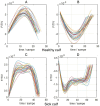Electrical impedance tomography in calves with bovine respiratory disease: correlations with clinical and blood gas findings
- PMID: 40376096
- PMCID: PMC12078298
- DOI: 10.3389/fvets.2025.1556943
Electrical impedance tomography in calves with bovine respiratory disease: correlations with clinical and blood gas findings
Abstract
Bovine respiratory disease (BRD) is a multifactorial global problem associated with long-term deleterious effects on the well-being of calves and marked financial losses. Prompt diagnosis of BRD, monitoring the success of treatment, and providing an accurate prognosis remain challenging because current methods for stall-side diagnosis are inadequate. To improve diagnosis in addition to clinical and morphological findings and gain insight into the respiratory dynamics of BRD, thoracic electrical impedance tomography (EIT) was used to evaluate calves with BRD (Group D; n = 42) and healthy calves (Group H; n = 13). Thoracic EIT is a non-invasive method of quantifying differences in impedance changes between various lung regions and impedance changes over time. A belt with 32 equidistantly mounted electrodes was placed around the thorax of non-sedated calves of both groups to measure impedance changes during respiration. The results were compared with the clinical findings and the California BRD scores. Compared with group H, Group D had decreased ventilation in the ventral lung regions (p = 0.05); ventilation shifted to the left lung lobes in calves with marked auscultatory changes (p = 0.013). In addition, the quartile ventilation ratio on inspiration (VQRi), used to quantify changes in impedance during inspiration, differed significantly between the two groups (p = 0.0039). Of all the EIT parameters, VQRi correlated most closely with paO2 and the A-a-gradient and was significantly lower in group D than in group H (p = 0.061). The results of EIT revealed differences in the inspiratory dynamics of clinically healthy and ill calves and correlated with the clinical and blood gas findings. Thus, EIT can be used alone or together with other diagnostic tools to identify and monitor BRD in calves.
Keywords: bovine; electrical impedance tomography; pneumonia; respiratory disease; thorax; ventilation.
Copyright © 2025 Bleul, Kluser, Waldmann and Gerspach.
Conflict of interest statement
The authors declare that the research was conducted in the absence of any commercial or financial relationships that could be construed as a potential conflict of interest.
Figures






Similar articles
-
Growth performance and hematological changes of weaned beef calves diagnosed with respiratory disease using respiratory scoring and thoracic ultrasonography.J Anim Sci. 2020 Nov 1;98(11):skaa345. doi: 10.1093/jas/skaa345. J Anim Sci. 2020. PMID: 33095858 Free PMC article.
-
Electrical impedance tomography for lung ventilation monitoring of the dog.Tierarztl Prax Ausg K Kleintiere Heimtiere. 2017 Feb 9;45(1):15-21. doi: 10.15654/TPK-150569. Epub 2017 Jan 17. Tierarztl Prax Ausg K Kleintiere Heimtiere. 2017. PMID: 28094413
-
Influence of different electrode belt positions on electrical impedance tomography imaging of regional ventilation: a prospective observational study.Crit Care. 2016 Jan 8;20:3. doi: 10.1186/s13054-015-1161-9. Crit Care. 2016. PMID: 26743570 Free PMC article.
-
Electrical impedance tomography: A compass for the safe route to optimal PEEP.Respir Med. 2021 Oct;187:106555. doi: 10.1016/j.rmed.2021.106555. Epub 2021 Jul 30. Respir Med. 2021. PMID: 34352563 Review.
-
Electrical Impedance Tomography for Cardio-Pulmonary Monitoring.J Clin Med. 2019 Aug 7;8(8):1176. doi: 10.3390/jcm8081176. J Clin Med. 2019. PMID: 31394721 Free PMC article. Review.
References
LinkOut - more resources
Full Text Sources

